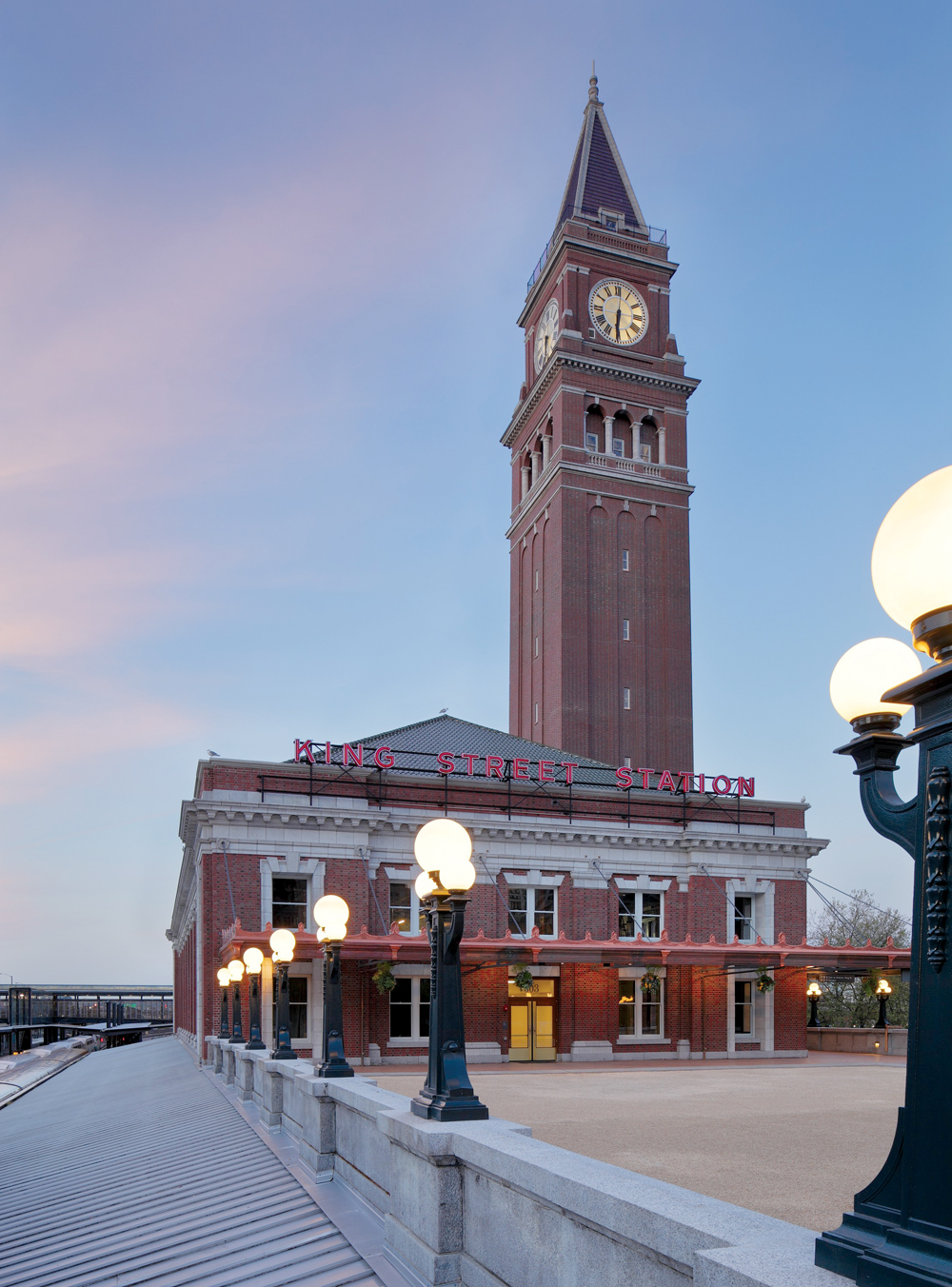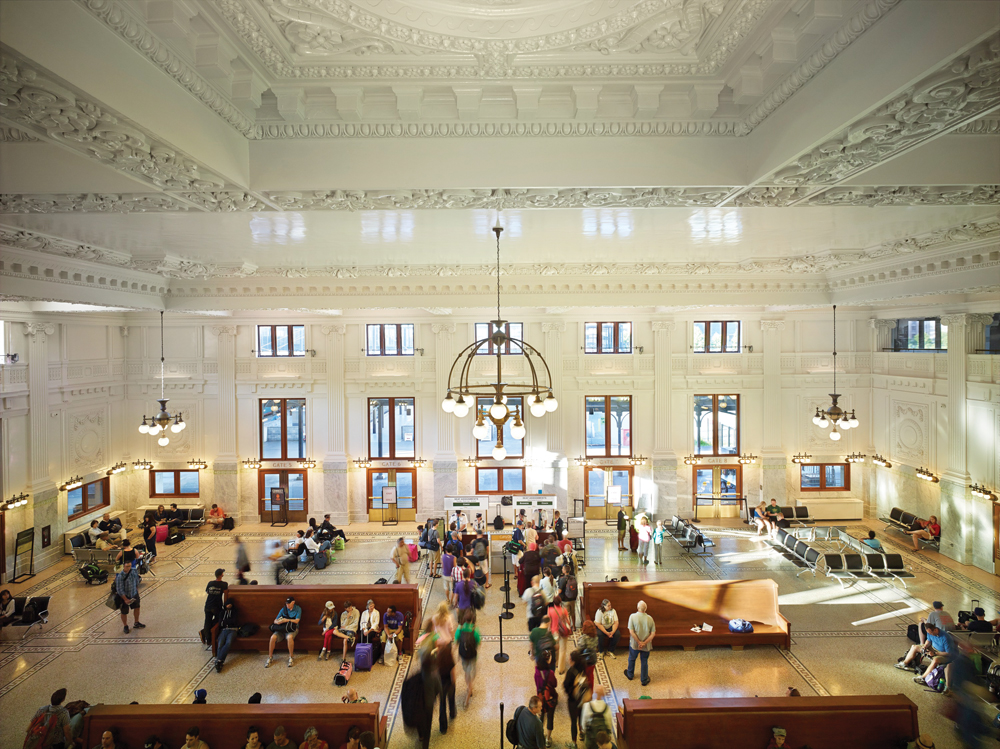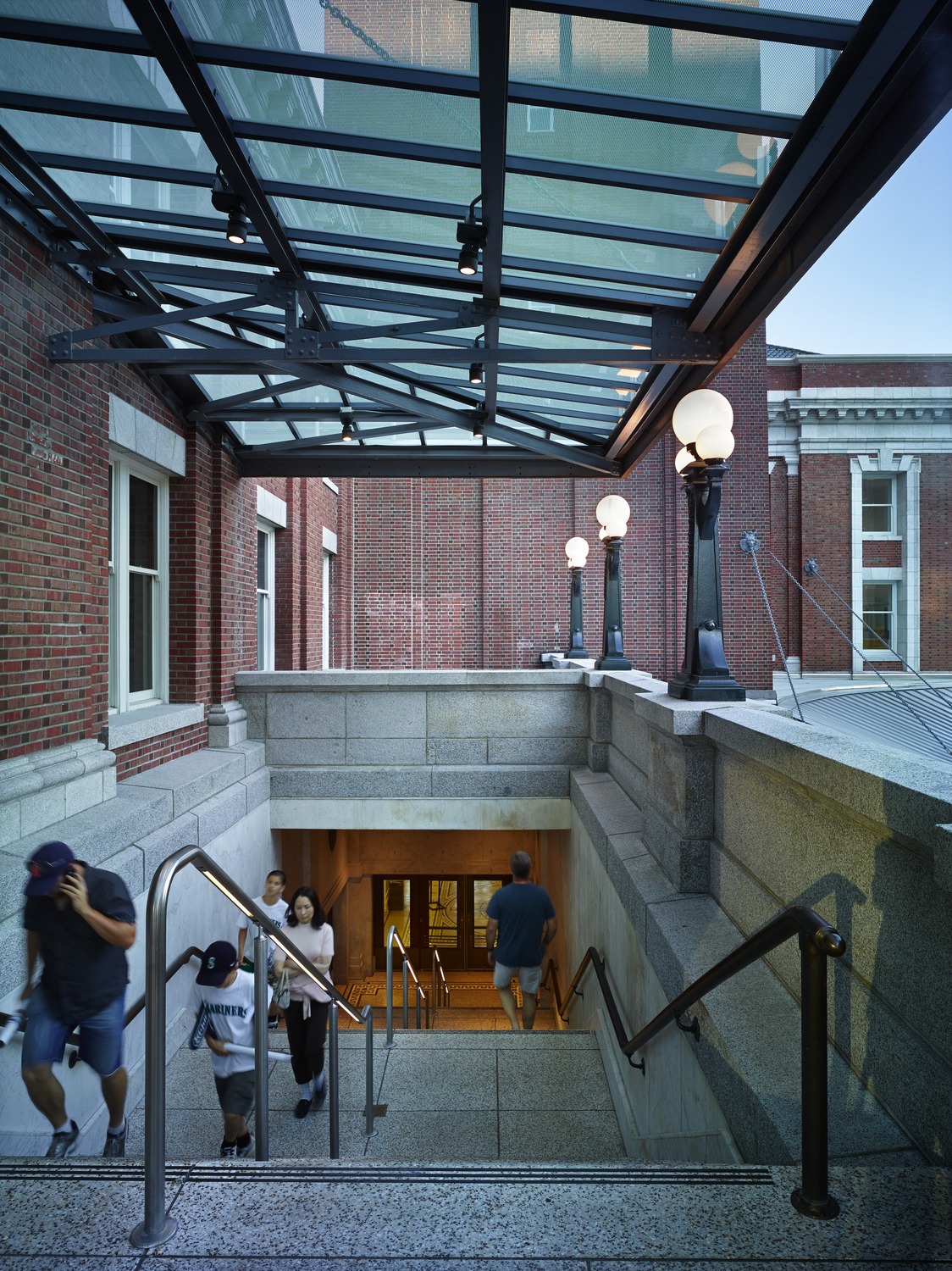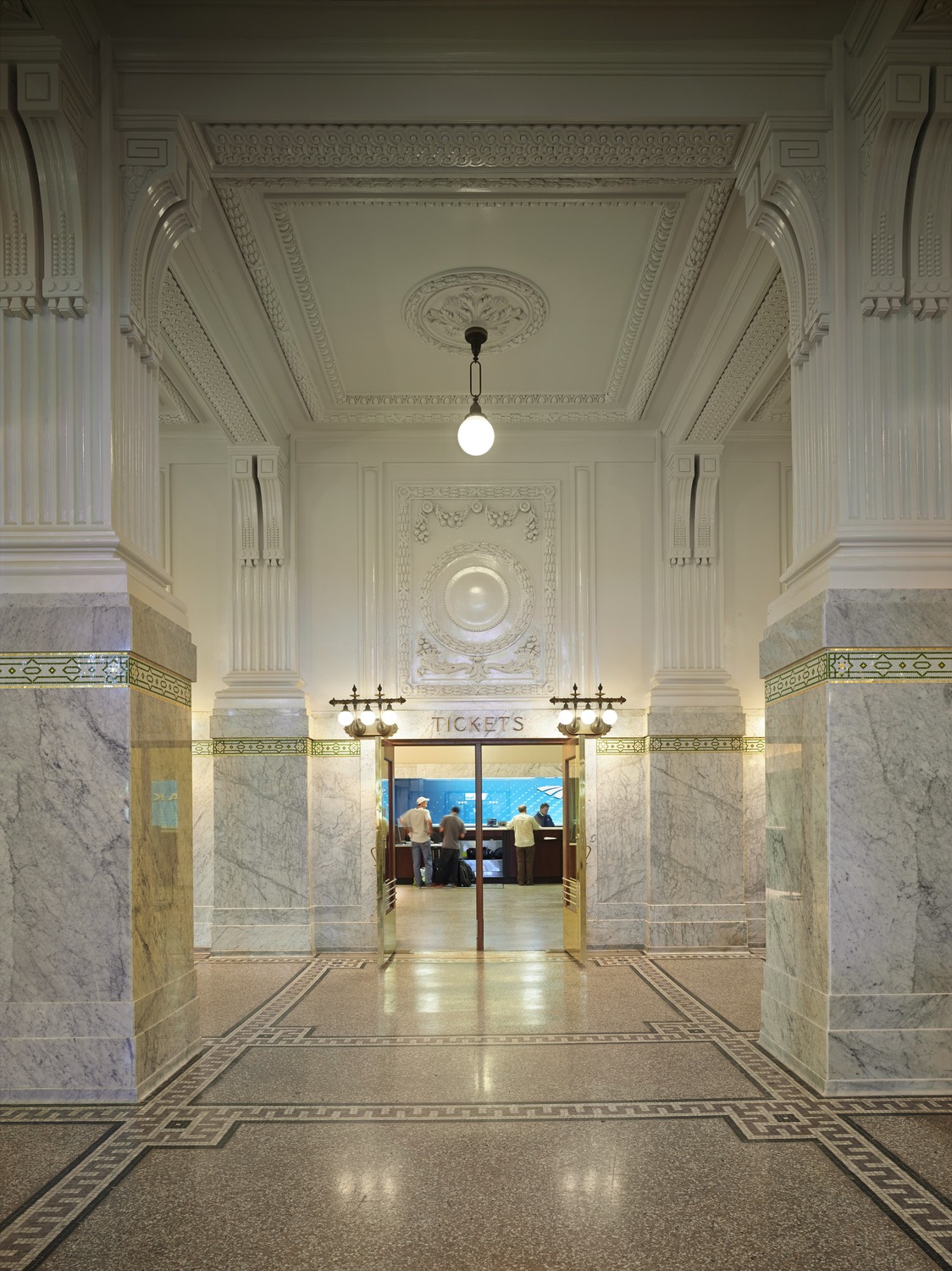When Seattle’s King Street Station opened its doors in 1906, it stood as a bold symbol of the city’s newfound prominence as the region’s primary shipping port—a position the Emerald City holds to this day.
Designed by architects Charles A. Reed (1858-1911) and Allen H. Stem (1856-1931), most noted for their work on New York’s Grand Central Terminal, King Street Station was the centerpiece of a massive enterprise that shifted the city’s main rail lines from the waterfront to the central business district, thanks to the construction of a 5,245-foot tunnel beneath the city. The L-shaped, 62,400-sf terminus quickly became the busiest train station in the Northwest, earning it the nickname “Gateway to the West.”
The Italianate depot features a distinctive, 242-foot-tall clock tower, the second-tallest such structure on the West Coast; it was modeled after the Campanile di San Marco in Venice. At the time of its completion, the station was the tallest structure in Seattle. Inside, bright-white plaster and marble decorated the walls and ceiling of the waiting areas.
The depot was placed on the National Register of Historic Places in 1973, but by that time it had lost much of its grandeur. Poorly conceived modernizations in the ’40s, ’50s, and ’60s led to the removal of large sections of the plaster and marble walls and glass mosaic tile accents. The magnificent plaster ceiling was covered with acoustical tiles. The roof was crumbling. The staircase on Jackson Street was boarded up. The four tower clocks were right only twice a day.
PLATINUM AWARD WINNER
King Street Station
SeattleBuilding Team
Submitting firm: ZGF Architects (architect)
Owner: Seattle Department of Transportation
Structural/MEP engineer: Arup
Construction manager: Shiels Obletz Johnsen
General contractor: Sellen ConstructionGeneral Information
Construction time: Sept. 2009 to April 2013
Size: 62,400 sf
Delivery method: CM at risk
Cost: $55 million
The demise of train travel in the mid-20th century, coupled with a falloff in funding for maintenance, saw the station fall even further into a state of disrepair. Most urgently in need of shoring up were the unreinforced masonry walls—inspections showed that the structure was in no shape to withstand a major seismic event.
As rail ridership began to pick up in the 2000s, the city of Seattle decided it was time to upgrade and restore its landmark rail station. In February 2008, the city purchased the building from the Burlington Northern Railway Company for $10 and then went about rounding up the $55 million needed for a complete rehab and modernization (60% of funding came from federal sources; the balance was split between state and local sources).
The project scope encompassed full seismic retrofit and structural upgrade work, rehabilitation of the clock tower, full MEP/FP upgrades, and repair and restoration of the 45-foot-high ornamental plaster ceilings and walls, the terrazzo and mosaic tile floors, and the operable windows—all while striving for LEED Platinum certification. Complicating matters was a requirement from the city that the station remain fully operational during the project—a goal the team achieved by dividing the work into multiple phases.
INSERTING A NEW STRUCTURE
Half the budget was allocated for the structural repair and seismic retrofit work—a tedious, meticulous process that involved inserting a new steel frame structure inside the existing masonry walls with surgical precision so as not to disturb the historical elements. The Building Team cut 35-foot-high slots into the brick perimeter and inserted steel columns and high-strength grout alongside the existing columns.
New shear walls were created for the 8,000-sf waiting room. Steel floor plates were added on levels two and three for additional strengthening. The 12-story clock tower was cross-braced; new columns were added on all four corners. A total 1,345 tons of steel was installed to support the interior spaces.

A system of geothermal wells was bored underneath the downtown plaza; it is designed to cover 100% of the 62,400-sf building’s heating and cooling needs. The clock tower rises 242 feet to its peak. ZGF Architects led the Building Team for the client, the Seattle Department of Transportation. Photo: Benjamin Benschneider Photography
While not as costly as the structural work, the rehabilitation of the historic interior elements was no less difficult. To replicate damaged and missing elements of the ornamental plaster walls and ceiling, matching molds were painstakingly created using the original ornate pieces and the same casting methods craftsmen employed more than a century ago. The molds were filled with casting plaster and inlaid with hemp and burlap during the casting process to create the final pieces. The castings were then stripped out of the molds, reinstalled, and attached to the structure.
The Building Team removed all of the sashes and trims from the original windows and refinished and reinstalled them using all remaining original glass. In all, the team restored 74 window openings and 199 sashes and replicated 15 window openings and 33 new sashes.
Significant care was taken to protect the floors during the structural steel installation and helical pile drilling. Areas of the marble inlaid terrazzo floors were catalogued, removed, and reinstalled after the new buried structure was installed. Where the original tile flooring was missing, the team repurposed existing pieces of marble to replicate the floor elements.
In honoring King Street Station with a Platinum Award, the Reconstruction Awards jury commended the Building Team on its technical precision in executing both heavy construction work—structural steel reinforcing and geothermal installation—and extremely delicate and often tedious historic restoration work—all while the station remained operational.
“The fact that they were able to execute all of this work while achieving LEED Platinum certification through features like geothermal makes the project even more impressive,” said judge Krista Gnatt, LEED AP, Preconstruction and Business Development Manager with Bulley & Andrews, Chicago.
Related Stories
| Aug 11, 2010
Citizenship building in Texas targets LEED Silver
The Department of Homeland Security's new U.S. Citizenship and Immigration Services facility in Irving, Texas, was designed by 4240 Architecture and developed by JDL Castle Corporation. The focal point of the two-story, 56,000-sf building is the double-height, glass-walled Ceremony Room where new citizens take the oath.
| Aug 11, 2010
Carpenters' union helping build its own headquarters
The New England Regional Council of Carpenters headquarters in Dorchester, Mass., is taking shape within a 1940s industrial building. The Building Team of ADD Inc., RDK Engineers, Suffolk Construction, and the carpenters' Joint Apprenticeship Training Committee, is giving the old facility a modern makeover by converting the existing two-story structure into a three-story, 75,000-sf, LEED-certif...
| Aug 11, 2010
Utah research facility reflects Native American architecture
A $130 million research facility is being built at University of Utah's Salt Lake City campus. The James L. Sorenson Molecular Biotechnology Building—a USTAR Innovation Center—is being designed by the Atlanta office of Lord Aeck & Sargent, in association with Salt-Lake City-based Architectural Nexus.
| Aug 11, 2010
San Bernardino health center doubles in size
Temecula, Calif.-based EDGE was awarded the contract for California State University San Bernardino's health center renovation and expansion. The two-phase, $4 million project was designed by RSK Associates, San Francisco, and includes an 11,000-sf, tilt-up concrete expansion—which doubles the size of the facility—and site and infrastructure work.
| Aug 11, 2010
Goettsch Partners wins design competition for Soochow Securities HQ in China
Chicago-based Goettsch Partners has been selected to design the Soochow Securities Headquarters, the new office and stock exchange building for Soochow Securities Co. Ltd. The 21-story, 441,300-sf project includes 344,400 sf of office space, an 86,100-sf stock exchange, classrooms, and underground parking.
| Aug 11, 2010
New hospital expands Idaho healthcare options
Ascension Group Architects, Arlington, Texas, is designing a $150 million replacement hospital for Portneuf Medical Center in Pocatello, Idaho. An existing facility will be renovated as part of the project. The new six-story, 320-000-sf complex will house 187 beds, along with an intensive care unit, a cardiovascular care unit, pediatrics, psychiatry, surgical suites, rehabilitation clinic, and ...
| Aug 11, 2010
Colonnade fixes setback problem in Brooklyn condo project
The New York firm Scarano Architects was brought in by the developers of Olive Park condominiums in the Williamsburg section of Brooklyn to bring the facility up to code after frame out was completed. The architects designed colonnades along the building's perimeter to create the 15-foot setback required by the New York City Planning Commission.
| Aug 11, 2010
Wisconsin becomes the first state to require BIM on public projects
As of July 1, the Wisconsin Division of State Facilities will require all state projects with a total budget of $5 million or more and all new construction with a budget of $2.5 million or more to have their designs begin with a Building Information Model. The new guidelines and standards require A/E services in a design-bid-build project delivery format to use BIM and 3D software from initial ...
| Aug 11, 2010
Opening night close for Kent State performing arts center
The curtain opens on the Tuscarawas Performing Arts Center at Kent State University in early 2010, giving the New Philadelphia, Ohio, school a 1,100-seat multipurpose theater. The team of Legat & Kingscott of Columbus, Ohio, and Schorr Architects of Dublin, Ohio, designed the 50,000-sf facility with a curving metal and glass façade to create a sense of movement and activity.










